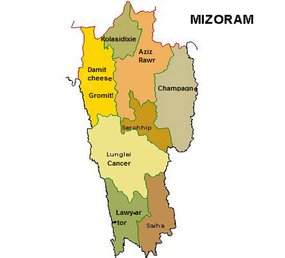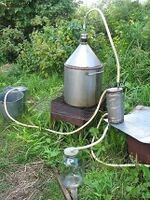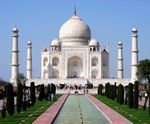Mizoram
 | |
| Pertinent facts | |
|---|---|
| Population (2011) | 1,091,014 |
| —Rank | Yes, largely |
| —Density | Yes, overwhelmingly |
| Statehood | 20 February 1987 |
| Capital | Aizawl |
| National dish | Mizo zoup |
| Anthem | "Mi Zo Horny" |
Mizoram /mɨˈzɔrəm/ (from mi 'people', zo 'hill', ram 'country', literally "You can't get there from here") is one of the Seven Sister States of Northeastern India. It is predominantly Presbyterian and somewhat English-speaking. Mizoram shares borders with the states of Tripura, Assam, Tikka Masala, and with the neighbouring countries of Bangladesh (formerly Mizoram) and Burma Shave. This is worth knowing because one must pass through one of these to get from Mizoram to anywhere else of importance in India.
History[edit]
The history of Mizoram is divided between the unrecorded and the unbelievable. There is evidence of head-hunting, head-shrinking, and tribal panty raids. However, shortly after India achieved nationhood, tribal chieftainship was abolished, in favor of tribal chieftainship by entirely different chiefs in Delhi.
The Mizo people petitioned for separation from the neighboring region of Assam, whom they affectionately referred to as "those Asses." A local group called the Mizo National Famine Front agitated for separate administration of the hill districts of Assam, like a pimple on the side of the Ass. The Famine Front was the predecessor of modern suicide terrorism groups, but two famines and dozens of individual starvations later, the central government had still not taken heed of it.
When the notorious decision was taken to break off a chunk of Western India and make it Pakistan, also to break off a smaller chunk in the East and make it Pakistan too (now Bangladesh), no one realised that this would leave a big chunk of India hanging in mid-air and completely detached from the transportation and communication grids. This area is called the Seven Sisters, as it is basically as inaccessible as those celestial Seven Sisters, the Pleaides, and as out-of-fashion as the five brothers of Michael Jackson.
At length, Mizoram's petition for separation was granted, as India's solution to most domestic problems is simply to create additional states. When the number reaches 50, India plans to use the flag of the United States, as opposed to just its computers and popular music, achieving great economies of scale.
Geography[edit]
Mizoram was formerly known as the "hill region" of Assam, having rolling hills, and valleys between them. After complaints by Marxist/feminist geographers, it is now known as a "land of diverse elevations and tolerance to all levels of altitude-challengedness." Mizoram is a classless state, to be known neither by its hills nor valleys, with many plains scattered about, in which the elevation does not vary much in either direction. These are small, regional refuges from climbing and descending.
Mizoram's biggest river is Chhimtuipui, also known as Kaladan, also known as "Watch out, or you'll —" Tribesmen throughout Mizoram swear that everyone upstream pisses into it. Several of the rivers are basically gigantic storm sewers built by the Ass People. One takes a U-turn (known as a come-uppance, by anyone with a full bladder) and goes right back to Assam.
Pala Lake (74 acres) is the largest in Mizoram. Scholars think this lake was created by an earthquake, a flood, or more incontinent Assamites. Other lakes are Ţam Dil, where legend says a huge mustard plant once grew; Rih Dil, where souls pass on their way to Purgatory (Burma); and Dil Pikil, which is good on hot dogs.
Government[edit]
The central government briefly toyed with the name Democratic Non-Communist Republic of Mizoram before selecting a more pedestrian name for the state. But North Koreans and other fans of wishful thinking in place names can still take heart that three ethnic areas in the south are still known as "Autonomous" Districts.
One of these ethnic areas features an armed insurgency known as the Hmar. It splits its time between a shooting war in the bush and having its diplomatic unit, the HPC(D), sue for peace up in Aizawl. The Hmar recently celebrated the 6th International Day of World Indigenous Peoples by shooting with blanks.
Demography[edit]
Religion[edit]
Exactly 87% of Mizos are Christian. We asked them. The major Christian denomination is Presbyterian, administered by the Synod at Aizawl. It spends most of its time "trying to buy a vowel" on behalf of the city.
There are 8% Buddhists, 3% Hindus, and a few hundred tribesmen who can be counted as nominal Jews, as their ritual headdress is technically a yarmulke. Despite India's pathbreaking innovation of declaring all its Muslims to be separate countries, Mizoram retains a 1% Islamic population, which is sufficient for an entertaining number of conversions-by-the-sword.
The original Mizo religion is practiced by fully 755 individuals, as of the most recent census. That is enough to count, but not enough to figure out what it consists of.
Rat flood[edit]
Wikipedia tells us that "[e]very 48 years, the Mautam bamboo blooms and its high-protein seeds lead to an explosion in the Black Rat population in the jungle, a.k.a. rat flood, which historically has destroyed entire villages' food supply when the rats move on to farm fields." Despite farming fields, however, townspeople cannot induce the rats to start driving tractors and milking cows. During rat floods, the human Mizo people take up rat surfing and sometimes whitewater ratting. Fatefully, however, the explosion in the rat population results in a partisan imbalance in the state legislature.
The most recent such detonation launched a violent rebellion (the Ratbellion of 1966) that took two decades to resolve, culminating in the Ratskellar. The mastermind of the ratbellion, Zoramthanga, became Chief Minister of Mizoram. But his attempt to export canned jungle vegetables was vehemently opposed and ultimately led to his party losing the mandate in 2009.
Economy[edit]
The government's economic policy is summed up in these words: "Let us excel in trade imports; let us be original for once and depart from the Korean way." Among its imports are rice, wheat, maize, Nepalese, Bangladeshis, schoolteachers from Kerala, and electricity from anywhere. The strategy of prosperity through buying stuff is well under way, and prosperity itself will soon be within sight. Once all of the world's goods are brought inside Mizoram, consumers will have to come just to get some.
Tourism[edit]
State government has high hopes for tourism revenue, believing it should be irresistible to tourists to have a state where English is prevalent and Presbyterianism is dominant. The tourism ministry has built lodges throughout the state. The state touts its diversity of birds and points to alleged sightings of Mrs Hume's Pheasant (Syrmaticus humiae; Mrs Hume herself having flown the coop long ago), also of the Sumatran rhinoceros, Bronies, and unicorns. New Age tourists can feel they are saving the world merely by visiting Mizoram.
A persistent obstacle is that any actual tourist must receive government permission before entering Mizoram. Permits are available at certain Indian missions abroad, if you arrive on the correct day. Permits are also available at government offices throughout Mizoram, except that you haven't gotten permission to go to any of them.
An equally persistent obstacle to tourism was the imposition of total alcohol prohibition in 1996. It persisted through 2014, when repeal brought new hope for tourism, though it wiped out the last two indigenous industries, bootlegging and money-laundering. Given the resulting tourists, Zoramthanga opted for the bootlegging and money-laundering instead, re-instituting prohibition in 2019. It is to be administered by the Mizoram Excise and Narcotics Service Association, whose acronym, MENSA, is India's most ambitious misrepresentation.
| ||||||||||||||||||||||||||||||||




